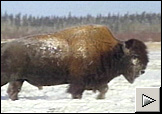|
|
An Ancient Bond with the LandCommunal HuntersCollapse and ContinuityBison and caribou remain central to the world-views and cultures of many First Peoples. Caribou hunting continues to be the mainstay of many northern communities. However, economies based on bison hunting collapsed with the almost complete destruction of the herds in the late 1800s. Despite this, the bison remains an important symbol of Aboriginal identity. Today, the image of the bison is often found as a decorative feature on clothes, blankets, emblems and various accessories. From an estimated population of 15 million bison in 1865, the herds were reduced to only a few hundred animals within 25 years. This destroyed the communal hunting practices that the bison had supported for more than 10,000 years. "A cold wind blew across the prairie when the last buffalo fell... a death-wind for my people." Hunkpapa Sioux Chief Sitting Bull
| |
